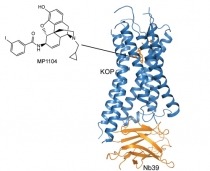New research funded by the National Institute on Drug Abuse illuminates the crystal structure of the activated kappa opioid receptor (KOR). The breakthrough could facilitate the development of new medications to treat pain and addiction.
The KOR is activated by one of the body’s natural opioid molecules, called dynorphin. When activated, the receptor produces analgesia. It also suppresses the rewarding effects of addictive drugs, reducing the motivation to use them, but also contributes to withdrawal and stress responses that motivate addictive behavior.
Researchers can use the newly revealed, fine-grained KOR structure to tease apart how the receptor’s interaction with dynorphin produces its diverse effects, and how its interactions with other molecules modulate those effects. Medicinal chemists may use this knowledge to design new medications that preserve or enhance dynorphin’s analgesic efficacy while improving treatments for addiction.
For a copy of the abstract, go to "Structure of a nanobody-stabilized active state of the kappa opioid receptor," published in Cell.
For more information about opioids, go to www.nida.nih.gov/drugs-abuse/opioids.
For more information, contact the NIDA press office at media@nida.nih.gov or 301-443-6245. Follow NIDA on Twitter and Facebook.
NIDA Press Office
301-443-6245
media@nida.nih.gov
About the National Institute on Drug Abuse (NIDA): NIDA is a component of the National Institutes of Health, U.S. Department of Health and Human Services. NIDA supports most of the world’s research on the health aspects of drug use and addiction. The Institute carries out a large variety of programs to inform policy, improve practice, and advance addiction science. For more information about NIDA and its programs, visit www.nida.nih.gov.
About the National Institutes of Health (NIH): NIH, the nation’s medical research agency, includes 27 Institutes and Centers and is a component of the U.S. Department of Health and Human Services. NIH is the primary federal agency conducting and supporting basic, clinical, and translational medical research, and is investigating the causes, treatments, and cures for both common and rare diseases. For more information about NIH and its programs, visit www.nih.gov.
NIH…Turning Discovery Into Health®
